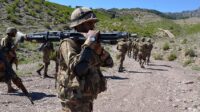Lung cancers are one of the haunting melancholia that dominate the album of human beings for the past few decades whose etiology of interest is cigarette smoking which is responsible for more than 90% of cases.1 Common Cell types of these cancers are Small Cell Lung Cancers (SCLC) and Non-Small Cell Lung Cancers (NSCLC). Squamous Cell Carcinoma, Adenocarcinomas and Large-Cell Carcinomas are subtypes of NSCLC. About 80% to 85% of Lung Cancers are NSCLCs.
The pathophysiology of these cancers is due to the inactivation of Tumor Suppressor Gene present on Chromosome 3p, mutation of P53 gene and KRAS oncogene activation. The clinical signs and symptoms of Lung Cancer are cough, hemoptysis, dyspnea, clubbing, hoarseness, Horner’s Syndrome, Pancoast’s syndrome, Lambart Eaten Syndrome, arrhythmia, Pericardial effusion, Superior vena cava obstruction, vocal cord paralysis due to involvement of the Left Recurrent Laryngeal Nerve by tumors at the left hilum and Paraneoplastic Syndromes like that of Hypertrophic Pulmonary Osteoarthropathy (HPOA).3 Investigations that are required to confirm the diagnosis of Lung Carcinoma are Chest X-Ray, CT scan of Chest, Biopsy and brushing using a flexible bronchoscope, Percutaneous Needle biopsy under CT or ultrasound guidance for histopathological diagnosis and Sputum cytology.4 The more invasive techniques of Thoracoscopy, Mediastinoscopy, Mediastinotomy and Open Lung Biopsy are aimed at establishing a tissue diagnosis and assessing the degree of spread (Staging) that determines resectability.5 Biomarker testing must be carried in order to ensure a smooth treatment plan especially in NSCLC. TTF-1, CK7 & CK20 are useful immunohistological markers to distinguish between Primary and Metastatic Lung Adenocarcinoma.6 If TTF-1 is +ve, CK7 is also +ve and CK20 is –ve then it suggests the Primary Adenocarcinoma of the Lung. PDL1 test measures the amount of PD-L1 proteins on Cancer cells. If PD-L1 turns out to be positive on Cancer cells then Oncologists may initiate Immune Checkpoint Inhibitors therapy.
In therapeutic arena, there are five types of medicaments and remedies available for Lung cancer: Surgery, radiation, chemotherapy, targeted therapy, and immunotherapy.7 Targeted therapies include Anaplastic Lymphoma Kinase (ALK) Inhibitors, Epidermal Growth Factor receptors Blockers (EGFR Inhibitors), ROSE1 & BRAF inhibitors and Tropomyosin Kinase receptor Blocker (Larotrectinib) etc. On May 6, 2020, the FDA of USA approved a kinase inhibitor called Tabrecta (Capmatinib) for the treatment of adult patients with NSCLC who are suffering from specific mutations that lead to Mesenchymal – Epithelial Transition or MET exon 14 Skipping. Immunotherapy includes Immune Check Point Inhibitors like that of PD-1 & PD-L1 Inhibitors which include Atezolizumab (target PD-L1), Durvalumab (target PD-L1), Nivolumab (target PD-1), Pembrolizumab (target PD-1) & Cemiplimab (target PD-1). The cure used for SCLC is radiation therapy and Chemotherapy that include Carboplatin or Cisplatin plus Etoposide.
During my survival as a medical practitioner in the COVID-19 pandemic, I pitched upon a patient of Metastatic Adenocarcinoma who was also co-infected with SARS-CoV-2 infection. After a long ordeal of two months, that patient showed the symptoms of recovery. During the recovery phase, a fresh Chest X-ray of the patient revealed Post COVID-19 Pulmonary Fibrosis and his dyspnea still persists even after passage of several months. From this anecdote, it is requested to the echelons of power around the globe to rattle their dags for the prevention of prevalence and incidence of COVID-19 infection in immunocompromised and Lung cancer patients. Second, the Oxygen concentrate machines and ventilators may be provided to the primary and secondary care hospitals of third world countries by philanthropists and bodies of international aid that should be powered by solar energy. The solarization project for generating power in primary and secondary care hospitals in developing countries would be a great leap forward in management arena.
Research should be conducted to discover drugs that can activate/induce the inactivated tumor suppressor genes/molecules and correct the mutations of tumor suppressor genes. Furthermore, the synthetic production of Tumor Suppressor molecules like that of P53 & Rb and their availability in the market may bring a new aurora of hope and blessings to the humanity. Studies should also be explored on the role of Medicinal herbs that activate tumor suppressors.8 Campaigns against smoking are already in place but our planet is in need of a true effort that can eradicate this menace once and for all. In addition, more energies should be brought into action to ferret out any role of Stem Cells in the treatment of lung cancers. Every newcomer to this world gives a new omen of hope to the caretaker and caregiver for a better future, such is the example of psychological arrow of time that grants hope to new discoveries and breakthroughs but never comes back. In short, the incantation to longevity is the essence of new breakthroughs and these quantum leaps can occur in the coliseum of lung cancers.
The writer is post graduate in Community Child health from Khyber Medical University (KMU) and currently serves as medical officer at Type-D Hospital, Tehsil Banda Daud Shah, District Karak. Can be reached at drfaisalali88@gmail.com.
REFERENCES:-
(1) Primary tumors of the Lung, Davidson’s Principles and Practice of Medicine, 23rd Edition, Page: – 599.
(2) Histopathological Classification of Lung Cancer, Bailey & Love’s Short Practice of Surgery, 24th Edition, Page: – 855.
(3) Lung Cancer, The Washington Manual of Medical Therapeutics, 35th Edition and page: – 684.
(4) Investigations, Davidson’s Principles and Practice of Medicine, 23rd Edition, Page: – 601.
(5) Bailey & Love’s Short Practice of Surgery, 24th Edition, Page: – 857.
(6) Role of TTF-1, CK20, and CK7 immunohistochemistry for diagnosis of primary and secondary lung adenocarcinoma, Yue-Chiu Su 1 , Yu-Chang Hsu, Chee-Yin Chai , Kaohsiung J Med Sci January 2006 • Vol 22 • No 1.
(7) Recent Advancements in Lung Cancer treatment by Sara Ryding, BSc, News Medical Life Sciences, August 12, 2020.
(8) Protection against cancer with Medicinal herbs via activation of Tumor Suppressor by Yasuko Kitagishi, Journal of Oncology, 20th November, 2012.
Stay tuned to Baaghi TV for more. Download our app for the latest news, updates & interesting content!






